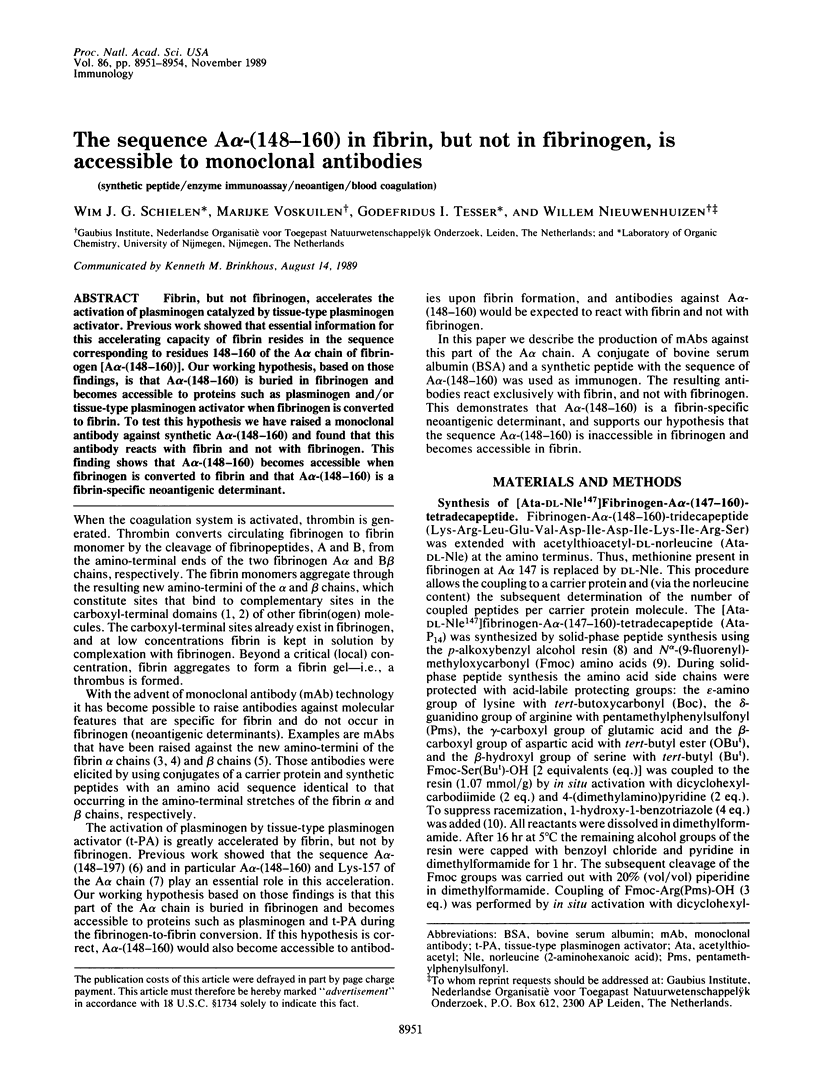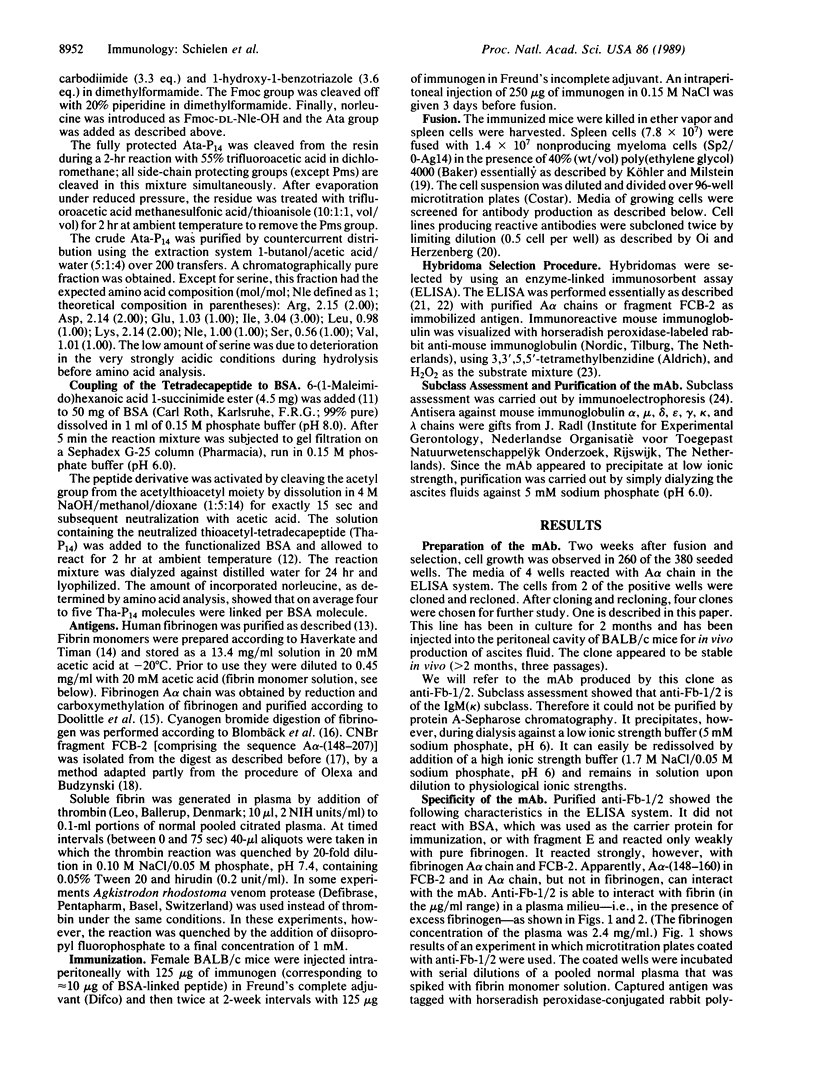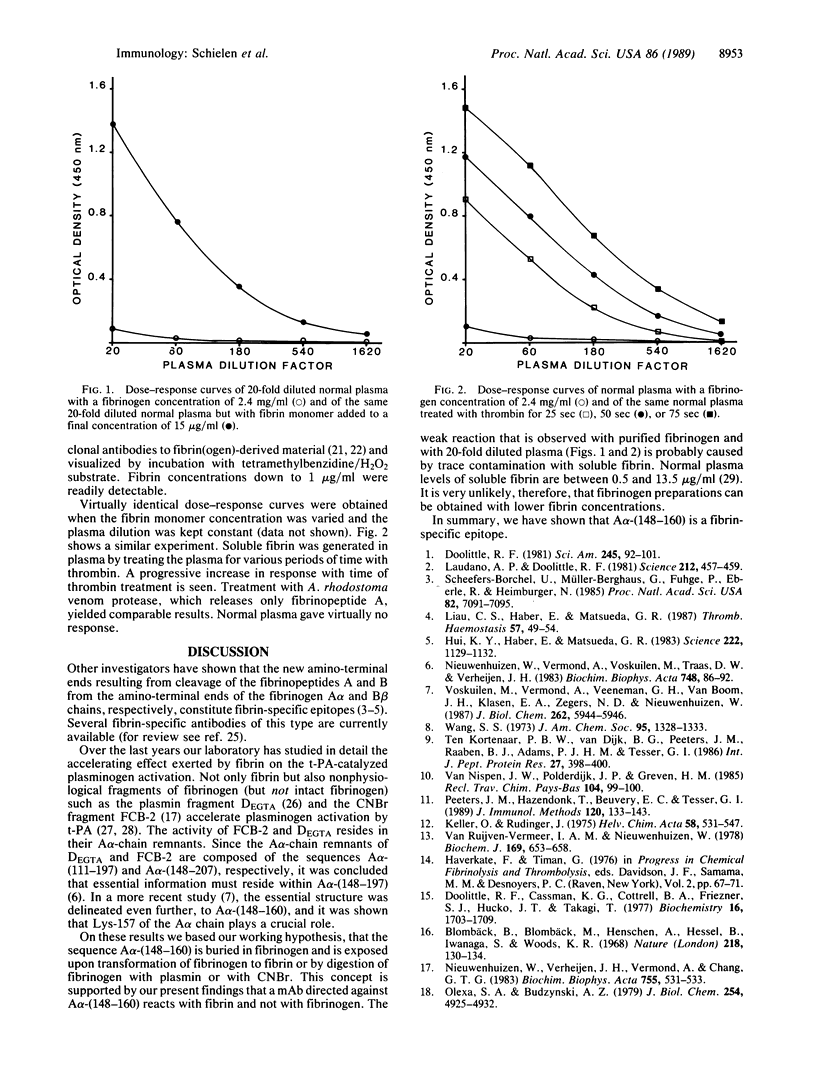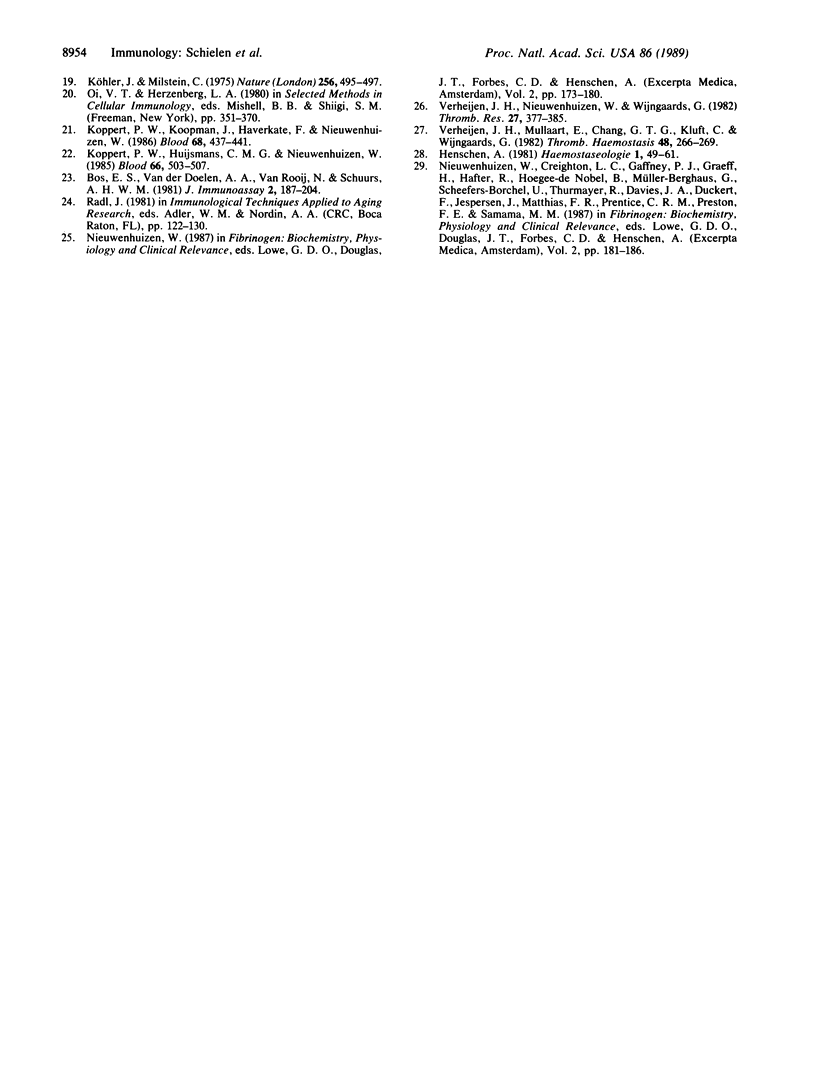Abstract
Fibrin, but not fibrinogen, accelerates the activation of plasminogen catalyzed by tissue-type plaminogen activator. Previous work showed that essential information for this accelerating capacity of fibrin resides in the sequence corresponding to residues 148-160 of the A alpha chain of fibrinogen [A alpha-(148-160)]. Our working hypothesis, based on those findings, is that A alpha-(148-160) is buried in fibrinogen and becomes accessible to proteins such as plasminogen and/or tissue-type plasminogen activator when fibrinogen is converted to fibrin. To test this hypothesis we have raised a monoclonal antibody against synthetic A alpha-(148-160) and found that this antibody reacts with fibrin and not with fibrinogen. This finding shows that A alpha-(148-160) becomes accessible when fibrinogen is converted to fibrin and that A alpha-(148-160) is a fibrin-specific neoantigenic determinant.
Full text
PDF



Selected References
These references are in PubMed. This may not be the complete list of references from this article.
- Blombäck B., Blombäck M., Henschen A., Hessel B., Iwanaga S., Woods K. R. N-terminal disulphide knot of human fibrinogen. Nature. 1968 Apr 13;218(5137):130–134. doi: 10.1038/218130a0. [DOI] [PubMed] [Google Scholar]
- Bos E. S., van der Doelen A. A., van Rooy N., Schuurs A. H. 3,3',5,5' - Tetramethylbenzidine as an Ames test negative chromogen for horse-radish peroxidase in enzyme-immunoassay. J Immunoassay. 1981;2(3-4):187–204. doi: 10.1080/15321818108056977. [DOI] [PubMed] [Google Scholar]
- Doolittle R. F., Cassman K. G., Cottrell B. A., Friezner S. J., Hucko J. T., Takagi T. Amino acid sequence studies on the alpha chain of human fibrinogen. Characterization of 11 cyanogen bromide fragments. Biochemistry. 1977 Apr 19;16(8):1703–1709. doi: 10.1021/bi00627a028. [DOI] [PubMed] [Google Scholar]
- Hui K. Y., Haber E., Matsueda G. R. Monoclonal antibodies to a synthetic fibrin-like peptide bind to human fibrin but not fibrinogen. Science. 1983 Dec 9;222(4628):1129–1132. doi: 10.1126/science.6648524. [DOI] [PubMed] [Google Scholar]
- Keller O., Rudinger J. Preparation and some properties of maleimido acids and maleoyl derivatives of peptides. Helv Chim Acta. 1975 Mar 12;58(2):531–541. doi: 10.1002/hlca.19750580224. [DOI] [PubMed] [Google Scholar]
- Koppert P. W., Huijsmans C. M., Nieuwenhuizen W. A monoclonal antibody, specific for human fibrinogen, fibrinopeptide A-containing fragments and not reacting with free fibrinopeptide A. Blood. 1985 Sep;66(3):503–507. [PubMed] [Google Scholar]
- Koppert P. W., Koopman J., Haverkate F., Nieuwenhuizen W. Production and characterization of a monoclonal antibody reactive with a specific neoantigenic determinant (comprising B beta 54-118) in degradation products of fibrin and of fibrinogen. Blood. 1986 Aug;68(2):437–441. [PubMed] [Google Scholar]
- Köhler G., Milstein C. Continuous cultures of fused cells secreting antibody of predefined specificity. Nature. 1975 Aug 7;256(5517):495–497. doi: 10.1038/256495a0. [DOI] [PubMed] [Google Scholar]
- Laudano A. P., Doolittle R. F. Influence of calcium ion on the binding of fibrin amino terminal peptides to fibrinogen. Science. 1981 Apr 24;212(4493):457–459. doi: 10.1126/science.7209542. [DOI] [PubMed] [Google Scholar]
- Liau C. S., Haber E., Matsueda G. R. Evaluation of monoclonal antifibrin antibodies by their binding to human blood clots. Thromb Haemost. 1987 Feb 3;57(1):49–54. [PubMed] [Google Scholar]
- Nieuwenhuizen W., Verheijen J. H., Vermond A., Chang G. T. Plasminogen activation by tissue activator is accelerated in the presence of fibrin(ogen) cyanogen bromide fragment FCB-2. Biochim Biophys Acta. 1983 Feb 22;755(3):531–533. doi: 10.1016/0304-4165(83)90261-1. [DOI] [PubMed] [Google Scholar]
- Nieuwenhuizen W., Vermond A., Voskuilen M., Traas D. W., Verheijen J. H. Identification of a site in fibrin(ogen) which is involved in the acceleration of plasminogen activation by tissue-type plasminogen activator. Biochim Biophys Acta. 1983 Oct 17;748(1):86–92. doi: 10.1016/0167-4838(83)90030-4. [DOI] [PubMed] [Google Scholar]
- Olexa S. A., Budzynski A. Z. Binding phenomena of isolated unique plasmic degradation products of human cross-linked fibrin. J Biol Chem. 1979 Jun 10;254(11):4925–4932. [PubMed] [Google Scholar]
- Peeters J. M., Hazendonk T. G., Beuvery E. C., Tesser G. I. Comparison of four bifunctional reagents for coupling peptides to proteins and the effect of the three moieties on the immunogenicity of the conjugates. J Immunol Methods. 1989 Jun 2;120(1):133–143. doi: 10.1016/0022-1759(89)90298-6. [DOI] [PubMed] [Google Scholar]
- Scheefers-Borchel U., Müller-Berghaus G., Fuhge P., Eberle R., Heimburger N. Discrimination between fibrin and fibrinogen by a monoclonal antibody against a synthetic peptide. Proc Natl Acad Sci U S A. 1985 Oct;82(20):7091–7095. doi: 10.1073/pnas.82.20.7091. [DOI] [PMC free article] [PubMed] [Google Scholar]
- Van Ruijven-Vermeer I. A., Nieuwenhuizen W. Purification of rat fibrinogen and its constituent chains. Biochem J. 1978 Mar 1;169(3):653–658. doi: 10.1042/bj1690653. [DOI] [PMC free article] [PubMed] [Google Scholar]
- Verheijen J. H., Mullaart E., Chang G. T., Kluft C., Wijngaards G. A simple, sensitive spectrophotometric assay for extrinsic (tissue-type) plasminogen activator applicable to measurements in plasma. Thromb Haemost. 1982 Dec 27;48(3):266–269. [PubMed] [Google Scholar]
- Verheijen J. H., Nieuwenhuizen W., Wijngaards G. Activation of plasminogen by tissue activator is increased specifically in the presence of certain soluble fibrin(ogen) fragments. Thromb Res. 1982 Aug 15;27(4):377–385. doi: 10.1016/0049-3848(82)90055-x. [DOI] [PubMed] [Google Scholar]
- Voskuilen M., Vermond A., Veeneman G. H., van Boom J. H., Klasen E. A., Zegers N. D., Nieuwenhuizen W. Fibrinogen lysine residue A alpha 157 plays a crucial role in the fibrin-induced acceleration of plasminogen activation, catalyzed by tissue-type plasminogen activator. J Biol Chem. 1987 May 5;262(13):5944–5946. [PubMed] [Google Scholar]
- Wang S. S. p-alkoxybenzyl alcohol resin and p-alkoxybenzyloxycarbonylhydrazide resin for solid phase synthesis of protected peptide fragments. J Am Chem Soc. 1973 Feb 21;95(4):1328–1333. doi: 10.1021/ja00785a602. [DOI] [PubMed] [Google Scholar]


